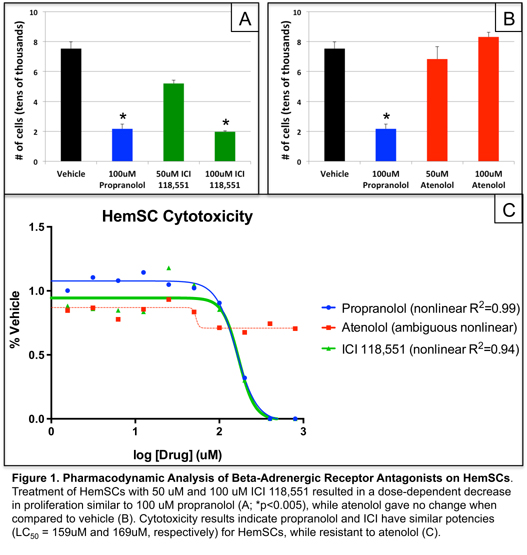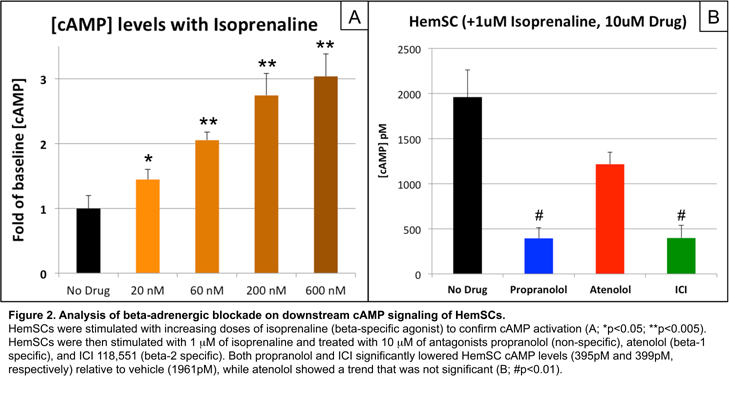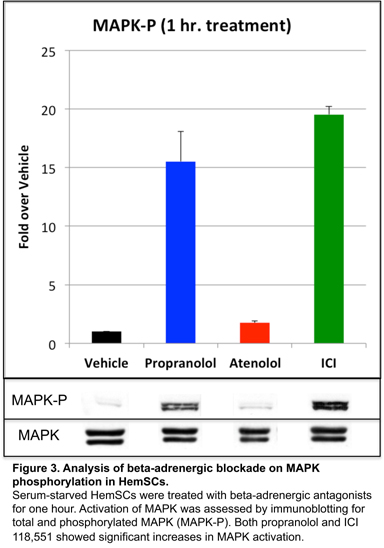|
Back to Annual Meeting
Beta-Adrenergic Signaling in Hemangioma Pathophysiology
Ryan W. England, BS, Naikhoba C.O. Munabi, BS, Carrie J. Shawber, PhD, Jan Kitajewski, PhD, June K. Wu, M.D..
Columbia University, New York, NY, USA.
BACKGROUND: Infantile hemangiomas (IH) are the most common benign tumor of infancy and are thought to originate from hemangioma stem cells (HemSCs). While there are currently no FDA-approved treatments for IH, propranolol has been recently discovered to be an effective treatment for problematic hemangiomas. Propranolol is a pan- beta-adrenergic receptor antagonist, suggesting that the beta-adrenergic signaling pathway plays a role in IH pathology. We hypothesized that propranolol’s effects are preferentially mediated via the beta-1 and/or beta-2 adrenergic receptors in HemSCs.
METHODS: CD133+ HemSCs isolated from resected IH specimens were treated with beta-1 adrenergic receptor selective antagonist, atenolol, or beta-2 adrenergic receptor selective antagonist, ICI 118,551 (ICI), and compared to propranolol. Effects of beta-adrenergic blockade in HemSCs were assessed by proliferation assay using a WST-8 cell counting kit, and cytotoxicity assay using the fluorescence-based digital image microscopy system, DIMSCAN. Effects of beta-adrenergic blockade on downstream effectors cAMP and mitogen-activated protein kinase (MAPK) were assessed. cAMP levels after isoprenaline stimulation were measured using a LANCE Ultra cAMP kit. The presence of endogenous MAPK and activated phosphorylated MAPK-P were determined by immunoblotting, and quantified using Image J. Student’s t-test and Prism were used for statistical analysis.
RESULTS: ICI treatment resulted in a dose-dependent decrease in HemSC proliferation, similar to propranolol (p<0.005; Figure 1A), while atenolol treatment did not alter HemSC proliferation (Figure 1B). Cytotoxicity results showed propranolol and ICI with nearly identical potencies for HemSCs (LC50=159uM and 169uM, respectively), while HemSCs were resistant to atenolol (Figure 1C). Activation of beta-adrenergic signaling with isoprenaline elevated HemSC cAMP levels in a dose dependent manner (1961pM; Figure 2A), and was significantly inhibited by the presence of both propranolol (395pM; p<0.01) and ICI (399pM; p<0.01), but not atenolol (Figure 2B). MAPK activation was observed in the presence of both propranolol (15.5-fold) and ICI (19.5-fold), while atenolol had no effect (Figure 3).
CONCLUSIONS: The beta-2 selective antagonist ICI mirrored the effects of propranolol, as seen by reduced proliferation, increased cytotoxicity, cAMP blockade, and MAPK activation in HemSCs. The beta-1 selective antagonist atenolol had little effect. Thus, effectiveness of propranolol in treating IH may be mediated via the beta-2 adrenergic receptor pathway. The development and use of beta-2 selective antagonists for hemangiomas would minimize potential adverse effects from non-selective beta-adrenergic antagonists such as bradycardia and hypotension that has been associated with beta-1 inhibition.



Back to Annual Meeting
|









